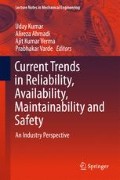Abstract
Condition based maintenance scheduling is a promising approach towards effective track possession management in railway transport. If the maintenance tasks arising from condition monitoring and inspection of railways are efficiently scheduled, high service quality and capacity would be assured. In this paper, the authors presents a short-term maintenance scheduling problem to efficiently use available train-free periods for restoration of potential failures such that availability and capacity are maximised. The formulated problem focuses on reducing the possession cost and penalty cost. It is modelled as a quadratically constrained mixed integer programming problem and solved using a branch and cut algorithm. A case study on the Swedish iron ore line is used to demonstrate the use of the scheduling approach for effective track possession management.
Access this chapter
Tax calculation will be finalised at checkout
Purchases are for personal use only
References
CENELEC EN 60300-3-14 (2004) Dependability management part 3-14: application guide-maintenance and maintenance support. In: European committee for electrotechnical standardization
Dekker R, Budai G (2002) An overview of techniques used in planning railway infrastructure maintenance. In: IFRIM maintenance management modelling conference, Växjo, Sweden
CEN EN 13306 (2010) Maintenance terminology. In: European committee for standardization
Paragreen J (2011) High level breakdown of maintenance activities—AUTOMAIN project deliverable 2.1. In: 7th framework programme—EU research
Trafikverket (2007) Roadmap to Banverket’s maintenance strategy (Vägledning till Banverkets underhållsstrategi BVH 800). Trafikverket
Trafikverket (2005) Safety inspection of railway infrastructure (BVH 807.30—Säkerhetsbesiktning av fasta anläggningar). Trafikverket
Stenström C, Parida A, Galar D (2014) Performance indicators of railway infrastructure. Int J Railway Technol 1(3):1–18
Higgins A (1998) Scheduling of railway track maintenance activities and crews. J Oper Res Soc 49:1026–1033
den Hertog D, van Zante-de Fokkert JI, Sjamaar SA, Beusmans R (2005) Optimal working zone division for safe track maintenance in The Netherlands. Accident Anal Prevent 37(5):890–893
Cheung BSN, Chow KP, Hui LCK, Yong AMK (1999) Railway track possession assignment using constraint satisfaction. Eng Appl Artif Intell 12(5):599–611
Peng F, Kang S, Li X, Ouyang Y, Somani K, Acharya D (2011) A heuristic approach to the railroad track maintenance scheduling problem. Comput Aided Civil Infrastruct Eng 26(2):129–145
Budai G, Huisman D, Dekker R (2006) Scheduling preventive railway maintenance activities. J Oper Res Soc 57:1035–1044
Zhang T, Andrews J, Wang R (2013) Optimal scheduling of track maintenance on a railway network. Qual Reliab Eng Int 29(2):285–289
Forsgren M, Aronsson M, Gestrelius S (2013) Maintaining tracks and traffic flow at the same time. J Rail Transp Plan Manag 3(3):111–123
Wolsey LA, Nemhauser GL (2014) Integer and combinatorial optimization. Wiley
Junger M, Liebling TM, Naddef D, Nemhauser GL, Pulleybank WR, Reinelt G, Rinaldi G, Wolsey LA (2010) 50 years of integer programming 1958–2008. Springer, Berlin
Gurobi optimizer reference manual (2015) http://www.gurobi.com
Acknowledgments
The authors wish to thank Trafikverket and Luleå Railway Research Centre for financial support. We also appreciate Prof. Inge Söderqvist for his fruitful discussions.
Author information
Authors and Affiliations
Corresponding author
Editor information
Editors and Affiliations
Rights and permissions
Copyright information
© 2016 Springer International Publishing Switzerland
About this paper
Cite this paper
Famurewa, S.M., Nissen, A., Kumar, U. (2016). Scheduling of Railway Infrastructure Maintenance Tasks Using Train Free Windows. In: Kumar, U., Ahmadi, A., Verma, A., Varde, P. (eds) Current Trends in Reliability, Availability, Maintainability and Safety. Lecture Notes in Mechanical Engineering. Springer, Cham. https://doi.org/10.1007/978-3-319-23597-4_30
Download citation
DOI: https://doi.org/10.1007/978-3-319-23597-4_30
Published:
Publisher Name: Springer, Cham
Print ISBN: 978-3-319-23596-7
Online ISBN: 978-3-319-23597-4
eBook Packages: EngineeringEngineering (R0)

